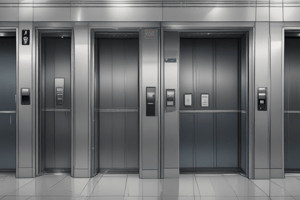Podcast
Questions and Answers
विज्ञानानुसार, १९ व्या शतकात विद्युत वापरून घडवलेले उत्तरण कोणते असले?
विज्ञानानुसार, १९ व्या शतकात विद्युत वापरून घडवलेले उत्तरण कोणते असले?
- हाइड्रोलिक असंधान
- प्रदक्षिणी स्पर्धा
- मॅग्नेटिक लेविटेशन सिस्टम
- प्नेउमेटिक ट्यूब सिस्टम (correct)
१८५७ मध्ये न्यूयॉर्कसाठी पहिले सफळ यात्री एलेवेटर कुठल्या इमारतीत स्थापित केले गेले होते?
१८५७ मध्ये न्यूयॉर्कसाठी पहिले सफळ यात्री एलेवेटर कुठल्या इमारतीत स्थापित केले गेले होते?
- Washington Irving Building (correct)
- Magnetic Levitation Building
- Geotron Building
- Elisha Otis Building
१९ व्या शतकात, एलेवेटर प्रौद्योगिकीसाठी कोणती सुरक्षा कन्ट्रोल प्रणाली लागू केली जाते?
१९ व्या शतकात, एलेवेटर प्रौद्योगिकीसाठी कोणती सुरक्षा कन्ट्रोल प्रणाली लागू केली जाते?
- मॅग्नेटिक लेविटेशन सिस्टम
- प्रदक्षिणी स्पर्धा
- निःसंप्रेषण संचार प्रणाली
- जिओट्रॉन (correct)
एलिव्हेटर सुरक्षिततेसाठी कोणतं महत्त्वाचं साधन आहे?
एलिव्हेटर सुरक्षिततेसाठी कोणतं महत्त्वाचं साधन आहे?
एलिव्हेटरचे कोणते सिद्धांत मानवसृजित उत्कृष्टतेचा एक प्रतिनिधिक उदाहरण आहे?
एलिव्हेटरचे कोणते सिद्धांत मानवसृजित उत्कृष्टतेचा एक प्रतिनिधिक उदाहरण आहे?
पहिले एलेवेटर कसे हाती मोहित होते?
पहिले एलेवेटर कसे हाती मोहित होते?
सुरक्षा आणि नुसतं स्थिरता कसे अपेक्षित करतात?
सुरक्षा आणि नुसतं स्थिरता कसे अपेक्षित करतात?
एलिव्हेटरचा हैद्रोलिक प्रणालीत समावेश कसा असतो?
एलिव्हेटरचा हैद्रोलिक प्रणालीत समावेश कसा असतो?
'Biometric access control' मुळे कोणते प्रकारे होते?
'Biometric access control' मुळे कोणते प्रकारे होते?
कोनता अंतरक्रिया संरक्षण प्रभावीपणे एलिव्हेटर काम करू शकतो?
कोनता अंतरक्रिया संरक्षण प्रभावीपणे एलिव्हेटर काम करू शकतो?
मुलांना ते कोणते साधन समजून देऊन, सुरक्षित प्रक्रिया कसे कार्य करतं?
मुलांना ते कोणते साधन समजून देऊन, सुरक्षित प्रक्रिया कसे कार्य करतं?
Study Notes
Exploring the World of Elevators
Elevators have become indispensable in our daily lives, enabling us to move effortlessly between floors in tall buildings. Their impact goes beyond mere convenience; elevators embody fascinating facets of human ingenuity across various fields, from science and engineering to history and technology. Let's delve into these aspects more deeply.
Science Behind Lift Mechanism
An elevator is essentially a machine designed to lift people vertically over great distances via a system called traction hoisting. It operates using one of two primary methods: hydraulic systems—where fluid pressure moves a piston upwards, or traction systems where cables or ropes connected to car counterweights and pulleys facilitate vertical movement. Aside from technical advancements improving reliability and safety, understanding fundamental physical principles such as conservation of energy, friction effects, and material behavior remains integral to this field.
Safety features like automatic doors with sensors or the emergency brake system, which stops the elevator immediately upon losing power or cable failure, also rely heavily on scientific knowledge. Moreover, incorporating sensors and electronic control devices has led to innovations like destination dispatch, optimizing ride times by grouping passengers headed in similar directions. Such enhancements highlight how interdisciplinary studies contribute significantly to modern elevator design and operation.
Historical Evolution
The first successful passenger elevator was installed in New York City's Washington Irving Building in 1857, developed by Elisha Otis. However, early elevators were manually operated via winding drum mechanisms, posing significant challenges since gravity always opposes upward motion. Pneumatic tube systems emerged around the 1880s, utilizing air pressure instead of mechanical means, but these did not experience widespread adoption due to their limited capacity and speed limitations.
Throughout the 19th century, electricity became increasingly central to elevator innovation, eliminating manual labor requirements while paving the way for faster speeds. In 1893 a European patent for a geared motor, driving through a belt for smooth and even speed distribution, brought further improvements. At present, hydraulic elevators are typically found only within low-rise buildings, whereas high-rises primarily utilize traction systems.
Technological Innovations: Safely Shooting Upward
Innovative technological developments continue shaping the future of elevators:
- Geotron: A linear induction motor substitutes traditional cables by floating magnets above each other, thus reducing maintenance costs and increasing efficiency.
- Magnetic levitation systems: Ultrafast versions of elevators with minimal friction, requiring less overall energy consumption.
- Biometric access control: Enforces secure identifications measures for user entry into lifts, minimizing unauthorized usage.
- Wireless communication systems: Provides real-time monitoring information, contributing to enhanced security and diagnostic capabilities.
As the construction industry continues erecting taller structures worldwide, it becomes imperative to develop innovative technologies capable of handling these new demands.
So, next time you step into an elevator, remember its complex roots in physics, engineering, historical milestones, and current technological aspirations. These factors converge synergistically to ensure your safe journey throughout towering edifices.
Studying That Suits You
Use AI to generate personalized quizzes and flashcards to suit your learning preferences.
Description
Delve into the fascinating world of elevators, exploring the science behind lift mechanisms, historical evolution from manual to modern systems, and technological innovations shaping the future. Learn about safety features, interdisciplinary studies, and the intricate balance of physics, engineering, and history within this essential mode of vertical transportation.




